Insects - barley
Contributors to this section: ICARDA, Syria (Siham Asaad, Abdulrahman Moukahal).
|
Contents: |
Scientific name
Trogoderma granarium Everts, 1898
Other scientific name
Trogoderma affrum Priesner, 1951
Importance
Seedborne.
Significance
The Khapra beetle is considered to be the most serious pest of stored products under hot dry conditions. Complete destruction of grain and pulses may occur in a very short time. In humid climates, the rates of increase of its competitors are so much greater that it has difficulty in establishing itself. However, in such areas, it lives at the inner edge of the expanding hot zone of stacks or bulks, in which heating has been induced by the activity of other species. In the EPPO region in the 1970s, T. granarium was rated as of considerable economic importance in Cyprus, Tunisia and Turkey.
Symptoms/damage
This pest causes loss of stored grain and consumes and breaks-up kernels. Young larvae feed on damaged seed, older larvae feed on whole grains. The larvae attack the embryo point or a weak place in the pericarp of grain or seed, and can cause significant weight loss when left undisturbed in stored grain, weight loss between 5-30%, in extreme cases of 70%, which may lead to significant reduction in seed viability. Severe infestation may cause unfavourable changes in chemical composition, can damage dry commodities of animal origin, large numbers of larval skins and setae may cause dermatitis and/or allergic reactions, contaminate grain with body parts and setae which are known to cause gastrointestinal irritation. Larvae move in and out of sacked material, weakening the sacks.
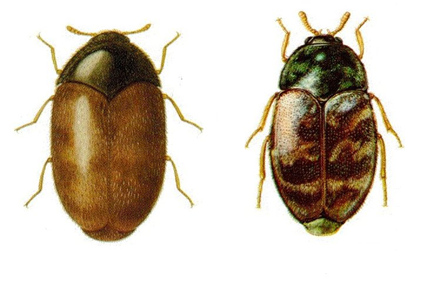 Khapra Beetle (from: agspsrv34.agric.wa.gov.au) |
Hosts
T. granarium is a general storage pest which occurs mainly on cereals and cereal products, oilseeds (especially groundnuts and oilcakes), pulses and pulse products, as well as on compound animal feed. The occurrence on other products, as on empty sacks and gums, etc., is probably accidental by cross infestation.
Geographic distribution
Worldwide.
Biology and transmission
The adults are short-lived, mated females living 4-7 days, unmated females 20-30 days and males 7-12 days; they do not fly and feed very little, if at all. Mating occurs about 5 days after emergence. The beetle can lay a full complement of eggs following a single mating, but a second mating greatly increases the total number of eggs produced: once-mated females lay 66 eggs, whereas twice-mated individuals lay about 58 and then 509 eggs after the respective matings. Delay in mating of 15-20 days results in up to 25% reduction in fecundity. The preoviposition period, which is not affected by humidity, is negligible at 40°C, 1 day at 35°C, 2 days at 30°C, 2-3 days at 25°C, and, at 20°C, no eggs are produced. Under optimum conditions, the female lays an average of about 50-90 eggs loosely in the host material. The eggs hatch within 3-14 days.
Complete development takes place within the heat range of 21 to over 40°C. The life cycle from egg to adult takes an average of 220 days at 21°C, 39-45 days at 30°C and 75% RH and 26 days at 35°C, the optimum. Development can take place at a relative humidity as low as 2%, at which the life cycle is prolonged.
The rate of increase of populations at 33-37°C is about 12.5 times per month: this compares with 20 times at 32-35°C (minimum RH 30%) for Rhyzopertha dominica and 25 times at 27-31°C (minimum RH 50%) for Sitophilus oryzae, the principal competitors of T. granarium as pests of whole grain.
In the zone where T. granarium is indigenous, where mean temperatures are consistently above 25°C, the larvae develop rapidly into the pupal stage, e.g. in 15 days at 35°C. If the temperature falls below 25°C for any period of time and, sometimes, if the larvae are very crowded, they may enter diapause and development ceases. The larvae are cold-hardy, surviving temperatures below -8°C. Diapause often occurs at constant temperature, below 30°C. In diapause, the larva can moult but is relatively inactive and rarely feeds. It tends to seek out crevices in the fabric of buildings. A larva can remain in this state for several years, but the provision of a new consignment of food, especially in warm conditions, may stimulate renewed development and pupation.
Young larvae are unable to feed on whole grains and depend on damaged grains or grain products for food (they readily attack softer foods such as nuts). Such damaged grains are always present in practice in lots of stored grain. Older larvae can feed on whole grains. The amount and condition of the food present affects the speed of development, but larvae can survive long periods (at least 13 months) without food. These starving larvae pupate within a week on the return of favourable conditions such as high temperature and availability of food. Starvation of dormant larvae for 3 months, followed by a brief period of feeding, results in the production of 41% of the normal number of eggs. However, this percentage is ample for the survival of the pest. One to three months of starvation does not affect the pupation rate of dormant larvae.
Detection/indexing method in place at ICARDA
Visual inspection.
 Khapra Beetle (source: pest.ceris.purdue.edu) |
Treatment/control
- Airport and maritime port interceptions.
- Detection by trapping or visual inspection.
- Signs of infestation include the larvae and cast skins, although larvae must be identified by microscopic examination.
- Eradication programmes utilize fumigants and surface sprays with deep penetration capability.
- Heat treatment has proven to be effective.
- Monitoring populations by using pheromone and larval traps.
- Preventative measures include good sanitation practices and exclusion.
- Spread mainly through international trade; therefore, inspection at ports and entry points is vital.
-
High risk areas that should be checked first include (USDA Fact Sheet, 1993):
- Cracks in walls and floors.
- Behind loose paint or rust.
- Along pallet, and the end-grain of pallet wood.
- Seams and ears of burlap bags.
- Low-light areas.
- Trash from cleaning equipment, and the equipment itself.
Procedure followed at the CGIAR Centres in case of positive test
- Fumigation with double dosage of phostoxin.
References and further reading
http://www.eppo.org/QUARANTINE/insects/Trogoderma_granarium/TROGGA_ds.pdf
http://www.npdn.org/Library/ViewDocument.ppt?filetype=ppt&DocumentId=5384
http://agspsrv34.agric.wa.gov.au/ento/pestweb/Query1_1.idc?ID=912133473
http://pest.ceris.purdue.edu/searchpest.php?selectName=INATANA
Scientific name
Sitophilus granarius L.
Other scientific name
Calandra granaria L.
Importance/significance
Serious pest of stored grains. Under quarantine in some countries.
Flour beetles, also known as "Bran bugs" are generally recognized as secondary pests of grain and therefore increase the feeding damage caused by primary pests. When present in large numbers, flour beetles will:
I) Cause flour to become prone to moulding and will also turn the product grey.
Il) Taint commodities with secretions from scent glands.
Symptoms/damage
The Granary Weevils are pests of stored grain and seeds. They develop inside whole grain kernels as small, white, wrinkled, grub-like larvae. There is generally no external evidence that the larvae have been eating and growing inside the seed until after about one month when the adult weevil chews through the seed coat and emerges. Grain weevils are important pests of farm-stored grain. They are frequently regarded as primary pests of grain since they are able to infest otherwise undamaged grain. Grain weevils will also attack other hard cereal products, e.g. pasta and spaghetti. Fine cereal products are unsuitable for weevil breeding purposes unless they become caked. Granary weevil infestations can result in reduced weight and quality of grain as a result of the larvae feeding on the endosperm. The germ is not always attacked so germination may take place, producing a weak seedling which is vulnerable to attack by moulds, bacteria and other insects. Both larvae and adults will feed upon grain. The grain can also be tainted with white, dusty excreta which contaminate the product as well as render it unpalatable. Heating of grain also occurs intern accelerating development of the insects and making the commodity liable to caking, moulding and even germination. Temperatures may be attained which actually kill the insects. Weevil-damaged grain can be readily recognized by the presence of large holes which are the exit holes of the emerging adults. Some idea of the huge numbers of weevils that can be generated is provided by the results of one study in which, five weeks after wheat was infested with larval forms, adults were seen to be leaving the grain at a rate of 100 weevils per kg of grain per day.
Hosts
Wheat and barley.
Geographic distribution
Worldwide; more important in temperate zone where it is one of the main stored grain pests.
Biology and transmission
The egg, larva, and pupa stages of these weevils occur in the grain kernels and are rarely seen. Feeding is carried out within the grain kernel and adults cut exit holes to emerge. Emergence holes of the granary weevil are fairly large and tend to be more ragged than smooth and round. Females drill a tiny hole in the grain kernel, deposit an egg in the cavity, then plug the hole with a gelatinous secretion. The egg hatches into a young larva which bores toward the centre of the kernel, feeds, grows and pupates there. New adults bore emergence holes from the inside, then leave to mate and begin a new generation. Female granary weevils lay from 36 to 254 eggs. At 27 - 30°C, 75 to 90 % eggs hatch in wheat with a moisture content of 13.5 to 19.6 % in three days. There are four larval instars and the developmental period is from three to five weeks. Pupation within the kernel requires 5 to 16 days. The life cycle is about 30 to 40 days during the summer, and 123 to 148 days during the winter, depending on temperature. The granary weevil is long-lived, surviving for seven to eight months as an adult. The female lays very few eggs at temperatures below 16 °C, but can survive for two months or more at about 2 °C.
Detection/indexing method in place at ICARDA
- Visual inspection.
Treatment/control
- Prevention is the best strategy to avoid insect problems in stored grains. Proper bin sanitation before introduction of new grain minimizes the need for pesticides. Good sanitation involves the removal of old grain and dust in and around the grain bin. This includes removal of old grain from corners, floors and walls. Any grain remaining when a bin is emptied can harbour insect infestations which will move into the new grain. Grain that is to be stored for longer than six months may need the protective application of an approved insecticide.
- Before grain is placed in a bin, it should be screened to eliminate fine materials and broken kernels. Grain placed in a clean bin should be checked at two-week intervals during warm months and at one-month intervals during cooler months for the presence of hotspots, mouldy areas and live insects. If any of these conditions exist, the grain should be aerated to lower the moisture level and temperature.
- Fumigation should only be used as a last resort. Because of the high toxicity of registered fumigants and technical knowledge needed for their proper use, a qualified pesticide applicator should be contacted if fumigation is required.
Procedure followed at the CGIAR Centres in case of positive test
- Fumigation.
References and further reading
http://ento.psu.edu/extension/factsheets/flour-beetle
http://entomology.ifas.ufl.edu/creatures/urban/beetles/red_flour_beetle.htm#habits
http://www.the-piedpiper.co.uk/th7a.htm
http://ohioline.osu.edu/hyg-fact/2000/2087.html
http://www.fsoe.se/nyhet/nyhet20.htm
http://www3.telus.net/conrad/insects/granaryw.html
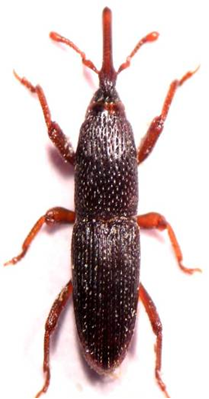
Sitophilus granarius (from: www.fsoe.se) |
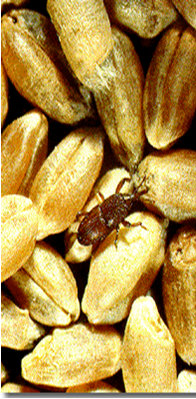
Sitophilus granarius (from: www3.telus.net) |
Confused flour beetle, Red flour beetle
Scientific name
Tribolium confusum Jaquelin Du Val, 1868 & Tribolium castaneum (Herbst)
Importance/significance
Antennae segments of the confused flour beetle increase in size gradually from the base to the tip to form a club of four segments; in the red flour beetle, the last three segments at the tip of the antennae are abruptly larger than the preceding ones, forming a three-segmented club. Also, the confused flour beetle has a straight-sided thorax, while the thorax of the red flour beetle has curved sides. The sides of the confused flour beetle head capsule are notched at the eyes so that a visible ridge is present. This ridge is absent in the red flour beetle when viewed from below
Symptoms/damage
The confused and red flour beetles cannot feed on whole, undamaged grain; they are, however, often found among dust, fines and dockage. The beetles do cause damage by feeding but probably cause more problems by contaminating the grain. Large numbers of dead bodies, cast skins and fecal pellets, as well as liquids (quinones), can produce extremely pungent odours in grain. The nauseous smell and taste caused by infestations of confused and red flour beetles can result in poor feed consumption by livestock and rejection by grain buyers. In most cases, the presence of live insects in a grain bin indicates that moisture buildup and moulds are also present. The combination of these three factors can greatly reduce the quality and value of grain.
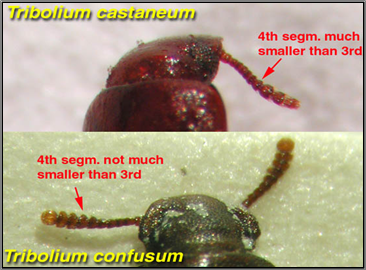 Distinguishing key (photo: www.uku.fi) |
Hosts
The red and confused flour beetles may be present in large numbers in infested grain, but are unable to attack sound or undamaged grain. The adults are attracted to light, but will go towards cover when disturbed. Typically, these beetles can be found not only inside infested grain products, but in cracks and crevices where grain may have spilled. They are attracted to grain with high moisture content and can cause a grey tint to the grain they are infesting. The beetles give off a displeasing odour and their presence encourages mould growth in grain.
Geographic distribution
All parts of the world; in cooler climate, restricted to warm storage. Tribolium confusum is commonly found in shipments from the topics.
Biology and transmission
The adult beetles are very active and move about rapidly when disturbed. The average life of adults is about one year. Females lay an average of about 450 eggs, which are small and clear white. The eggs are laid loosely on fine materials and broken kernels where the adults reside. The eggs are covered with a sticky secretion which the fine material adheres to. Fresh material placed in a grain bin will become rapidly infested if previous grain residue is not removed. Larvae (small brownish-white worms) hatch in five to twelve days and are full-grown in one to four months. Full grown larva are about three-sixteenths inch long and tinged with yellow. These larvae feed on fine materials and broken grain kernels. The larvae transform into small naked pupae, which are white at first and then gradually change to yellow and then to brown and shortly afterwards into the reddish-brown adult beetle. The period from egg to adult averages about six weeks under favourable weather conditions, but is greatly prolonged by cold weather, as is true of all grain pests. The life cycle of the red flour beetle is usually shorter than the confused flour beetle.
Detection/indexing method in place at ICARDA
- Visual inspection.
Treatment/control
- Prevention is the best strategy to avoid insect problems in stored grains. Proper bin sanitation before introduction of new grain minimizes the need for pesticides. Good sanitation involves the removal of old grain and dust in and around the grain bin. This includes removal of old grain from corners, floors and walls and grain that may have spilled on the exterior of the bin. Any grain remaining when a bin is emptied can harbor insect infestations which will move into the new grain. After the bin is cleaned, and all needed repairs have been made, the floor and wall surfaces both inside and outside the bin should be treated. Take special care to treat all cracks, crevices and areas around doorways and other places where insects could hide or enter. Spray the bins about four to six weeks prior to storing grain.
- Before grain is placed in a bin, it should be screened to eliminate fine materials and broken kernels. Grain placed in a clean bin should be checked at two-week intervals during warm months and at one-month intervals during cooler months for the presence of hotspots, mouldy areas and live insects. If any of these conditions exist, the grain should be aerated to lower the moisture level and temperature.
- Grain that is to be stored for longer than six months may need the protective application of an approved insecticide. Treatments can be applied as the grain is loaded into the bin through the use of a metering device calibrated to apply the proper amounts. After the grain is binned and leveled, a surface dressing can be applied to prevent insects from entering the grain on the surface. If infestation occurs in spite of these precautions, fumigation of the grain will be necessary. Because of the high toxicity of registered fumigants and technical knowledge needed for their proper use, a qualified pesticide applicator should be contacted to perform the fumigation.
Procedure followed at the CGIAR Centres in case of positive test
- Fumigation.
References and further reading
http://agspsrv34.agric.wa.gov.au/Ento/pestweb/Query1_1.idc?ID=-991113051
http://ento.psu.edu/extension/factsheets/weevils-on-stored-grain
http://www.grainscanada.gc.ca/storage-entrepose/pip-irp/gw-cg-eng.htm
http://www.stanford.edu/group/parasites/ParaSites2002/hymenolepsis/transmission.htm
http://evolutionlist.blogspot.com/2009/02/macroevolution-examples-and-evidence.html
http://www.uku.fi/~holopain/stt/Tribolium-comp.jpg

Damages caused by Grain weevil (photo: www.stanford.edu) |
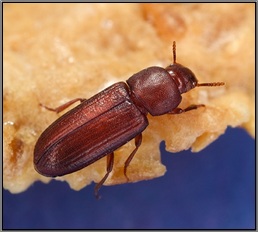
Adult insect (photo: http://evolutionlist.blogspot.com) |
Scientific name
Rhyzopertha dominica (Fabricius, 1792)
Importance/significance
Lesser Grain Borers are primary pests of grain and will therefore attack undamaged grain rendering it susceptible to attack by secondary pests. Both the adults and larvae feed on the grain creating floury dust and potentially leaving little but empty husks. The adults are active and may infest a large number of kernels whilst the larvae penetrate kernels and develop within the grain.
Symptoms/damage
Lesser Grain Borers mainly attack wheat, corn, rice and millet. Both the larvae and adults are primary pests. They bore irregular shaped holes into whole, undamaged kernels and the larvae, immature stages, may develop inside the grain. Larval and adult Lesser Grain Borers feeding in and on grain kernels may leave only dust and thin brown shells. A sweet, musty odour is often associated with infestations of this insect.
Hosts
Mainly wheat, corn, rice and millet.
Geographic distribution
Mainly in warmer countries. Carried in goods to temperate zones where they can survive in warm warehouse, it has spread through commerce to all parts of the world. It is most prominent in the United States, southern Canada, Argentina, India and Australia.
Biology and transmission
Females generally lay between 2 and 40 eggs. As this species are long lived, up to 500 eggs may be laid in total. Eggs are laid singly and in groups. The minimum time to complete the lifecycle under ideal conditions is 25 days, although such conditions are rarely found in the field. Larvae will moult two to four times before pupation which will usually take place inside grain. Rhizopertha have been observed to infest and attack other stored food commodities such as tobacco, nuts, beans, biscuits, cassava, cocoa beans, dried fruits, peanuts, spices and dried meats/fish. Larvae are well documented as being voracious feeders. It is usual for adults to grow to a size of 3 mm. Larger Grain Borers are, as the name suggests, slightly larger at 4 mm. Both have a distinctive shape, with a large pronotum, giving the appearance of having only two body sections when viewed from above.
The Lesser Grain Borer has three distinct antennal “club” with the last three segments being a good deal larger than the other segments. Although this antennal club is also exhibited by the larger grain borer, it can be used to differentiate the two as it is proportionally larger in the Lesser Grain Borer. The main distinguishing feature separating the two species is the shape of the posterior area of the elytra (wing cases) which is rounded in the Lesser Grain Borer, but blunt, almost rectangular in the Larger Grain Borer.
Detection/indexing method in place at ICARDA
- Visual inspection.
Treatment/control
- Inspection is very important to prevent infested materials being brought in to infest other goods. Warehouses and stores, especially feed and health food stores, should monitor for beetle infestations with pheromone traps. Store whole grains such as bird seed, popcorn, wheat berries, spice seeds, dried beans, and seeds for sprouting in insect-proof glass, metal, or plastic containers. Infested products should be discarded. Infestations in homes are sometimes a result of grain-stuffed animals or other ornaments.
- There is an unpleasant odour associated with infestations of Lesser Grain Borer that makes infested material unpalatable. Sanitation is very important in control of this and other stored product pests. Shelves should be vacuumed, paying careful attention to cracks and crevices, and wiped down with warm soapy water. Small, isolated infestations may be controlled with residual and space sprays. Large infestations usually require fumigation to control pest populations. Grain protectants are used to discourage infestations, but some are less effective against Lesser Grain Borer than they are against other insects.
Procedure followed at the CGIAR Centres in case of positive test
- Fumigation.
References and further reading
http://edis.ifas.ufl.edu/pdffiles/IG/IG11700.pdf
http://www.the-piedpiper.co.uk/th7t.htm
http://www.ca.uky.edu/entomology/entfacts/ef137.asp
http://www.valentbiosciences.com/environmental_science_division/lesser_grain_beetles.asp
http://www.centreinar.org.br/pragas/bostrichidae.html
Seed Health General Publication Published by the Centre or CGIAR
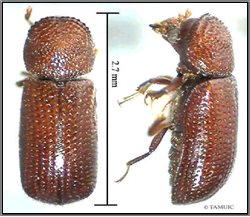
Adult insect |

Larva |
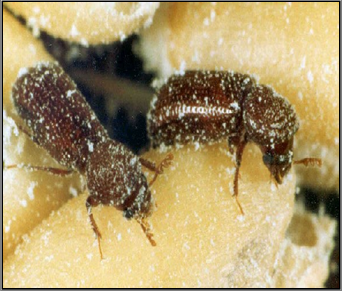
Damages caused by Lesser Grain Borer (photo: sgrl.csiro.au/) |
Comments
- No comments found





Leave your comments
Post comment as a guest